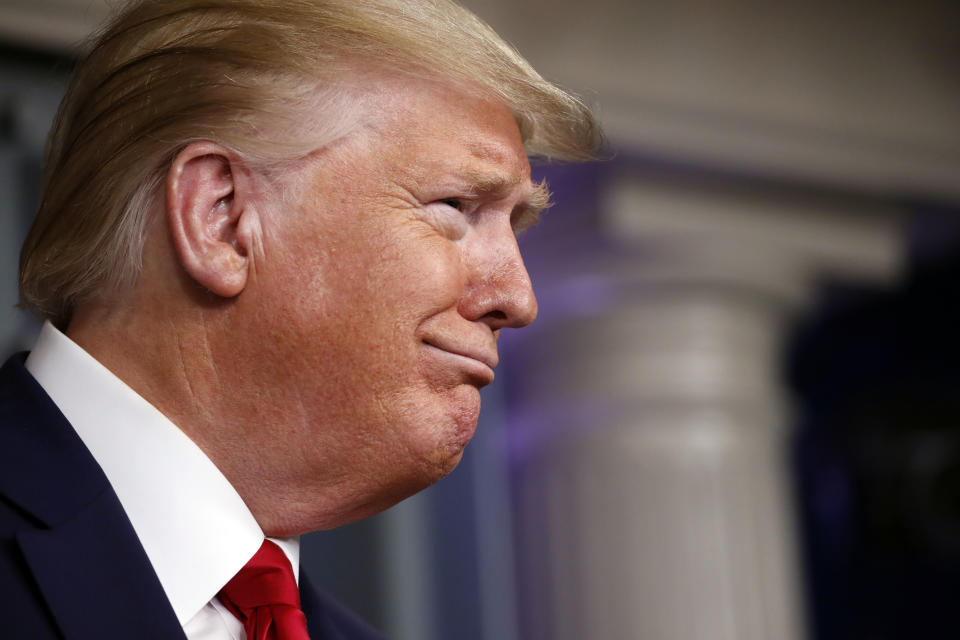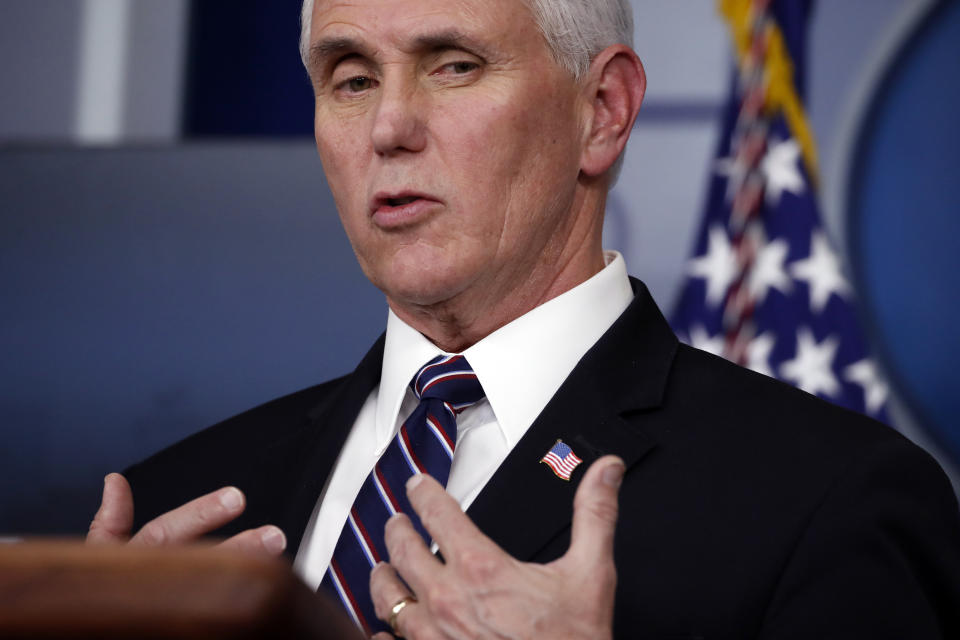Disillusionment grows over Trump's coronavirus briefings
On March 20, President Trump opened the daily briefing of the White House coronavirus task force with the news that “I had a very good telephone conversation — extremely good — with Sen. Schumer a little while ago” and praising the “tremendous spirit to get something done” on the part of Senate Democrats and Republicans.
That spirit of accommodation lasted until a few minutes into the question session that followed, when Peter Alexander, White House correspondent at NBC News, asked a question the president didn’t like.
The question was: “What do you say to Americans who are watching you right now who are scared?”
“I say that you’re a terrible reporter,” Trump answered, “that’s what I say.” He went on to accuse Alexander of asking a “nasty question” and to attack NBC’s corporate parent, Comcast, as “Con-Cast.”
Almost every day since, the White House has held a press briefing, usually in the late afternoon, featuring a long speech by the president followed by exchanges with reporters who ask either “nasty” questions (if they’re from mainstream media outlets he dislikes) or “very nice” ones (usually by the reporter from the pro-Trump One America News Network), then remarks by Vice President Mike Pence and one or more officials from the task force.
One session included what amounted to a presidential endorsement of a product called My Pillow and an appearance by its chief executive, Mike Lindell, a major Trump backer.
Recently, a number of news outlets have begun to question the value of the briefings. On Thursday the editorial board of the Wall Street Journal, which has been a reliable Trump supporter since he took office, joined those questioners.
In a piece titled “Trump’s wasted briefings,” the Journal’s editorial board wrote that “sometime in the last three weeks Mr. Trump seems to have concluded that the briefings could be a showcase for him. Perhaps they substitute in his mind for the campaign rallies he can no longer hold because of the risks.”

While this kind of criticism of Trump’s coronavirus briefings has been commonplace from commentators and hosts on CNN and MSNBC, it is notable from the Journal’s editorial page, which took aim at the president for fusing a public health crisis with political point scoring.
“The President’s outbursts against his political critics are also notably off key at this moment. This isn’t impeachment, and Covid-19 isn’t shifty Schiff. It’s a once-a-century threat to American life and livelihood,” the paper, which is owned by Rupert Murdoch, wrote.
During the briefing held on April 2, Trump demonstrated the blurring of lines between politics and public health, telling the nation, “This is not the time for politics,” then condemning “endless partisan investigations” of his administration.
“You see what happens,” Trump added when asked about a plan by congressional Democrats to conduct oversight of the administration’s handling of the coronavirus outbreak. “It’s witch hunt after witch hunt, and in the end the people doing the witch hunt have been losing, and they’ve been losing by a lot.”
The coronavirus outbreak has reshaped the 2020 political campaign. The president’s last big rally was held in Charlotte, N.C., on March 2, and as the Journal noted, the president has, at least in part, used the task force briefings to keep people focused on what he has to say.
“Not only do these televised coronavirus sessions veer toward the misleading when Trump is at the microphone, but they’re also incredibly self-serving and very long — most Hollywood movies run shorter than Trump’s March 31 briefing, which clocked in at 2 hours 11 minutes,” Politico’s media critic Jack Schafer wrote. “The complainers are also right when they note Trump is using the pressers as a replacement for his political rallies, put on hold by the virus which make them too dangerous to convene.”
The public’s hunger for credible information during this unprecedented national challenge has presented a dilemma for media organizations that have been critical, for instance, of Trump’s praise of the antimalarial drug hydroxychloroquine as a “game changer” in the fight against COVID-19 despite safety warnings from medical professionals and a lack of clinical trials.
Thanks to dubious claims like that, the New York Times and other papers removed the live stream of the coronavirus task force briefings from their websites.
“The health experts often have interesting information, so we’re very interested in that, but the president himself often does not,” Elisabeth Bumiller, Washington bureau chief for the New York Times, told the Washington Post.

The Journal, too, advocated turning over the briefings to Pence and his medical experts.
“If Mr. Trump wants to make his briefings more helpful to the country, here’s our advice. Make them no more than 45 minutes, except on rare occasions,” the Journal’s editorial board wrote. “Let Mr. Pence lead them each day, focusing on one issue or problem. Mr. Pence can take the questions, and Mr. Trump can show up twice a week to reinforce the message.”
Of course, Trump is the president, and he’s not accustomed to playing second fiddle to anyone in his administration, even the person he named to head the government’s response to the coronavirus outbreak.
And as he tweeted on March 29, Trump is quite aware that the task force briefings are watched by millions of Americans.
Because the “Ratings” of my News Conferences etc. are so high, “Bachelor finale, Monday Night Football type numbers” according to the @nytimes, the Lamestream Media is going CRAZY. “Trump is reaching too many people, we must stop him.” said one lunatic. See you at 5:00 P.M.!
— Donald J. Trump (@realDonaldTrump) March 29, 2020
While it’s impossible to say what exact effect the daily briefings are having on Trump’s approval rating regarding his response to the coronavirus outbreak, a Yahoo News/You Gov poll released Wednesday found growing disapproval over the past two weeks. Half of Americans surveyed now say they disapprove of Trump’s coronavirus response versus 42 percent who approve, a near reversal of a Reuters/Ipsos survey released two weeks’ worth of briefings earlier.
Trump’s disdain for a large swath of the U.S. press corps is on daily display at his coronavirus briefings, during which he frequently berates reporters. As the Journal noted in its editorial, the format of the briefings seems to invite conflict, playing right into Trump’s guiding ethos to “always hit back” at those who attack him. It comes as no surprise, then, that the president stayed true to form on Thursday when responding to the latest newspaper to question the usefulness of his task force performances.
The Wall Street Journal always “forgets” to mention that the ratings for the White House Press Briefings are “through the roof” (Monday Night Football, Bachelor Finale, according to @nytimes) & is only way for me to escape the Fake News & get my views across. WSJ is Fake News!
— Donald J. Trump (@realDonaldTrump) April 9, 2020
_____
Click here for the latest coronavirus news and updates. According to experts, people over 60 and those who are immunocompromised continue to be the most at risk. If you have questions, please refer to the CDC’s and WHO’s resource guides.
Read more:





